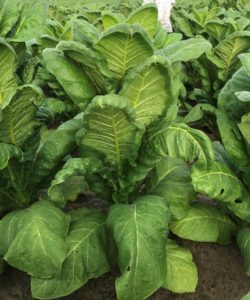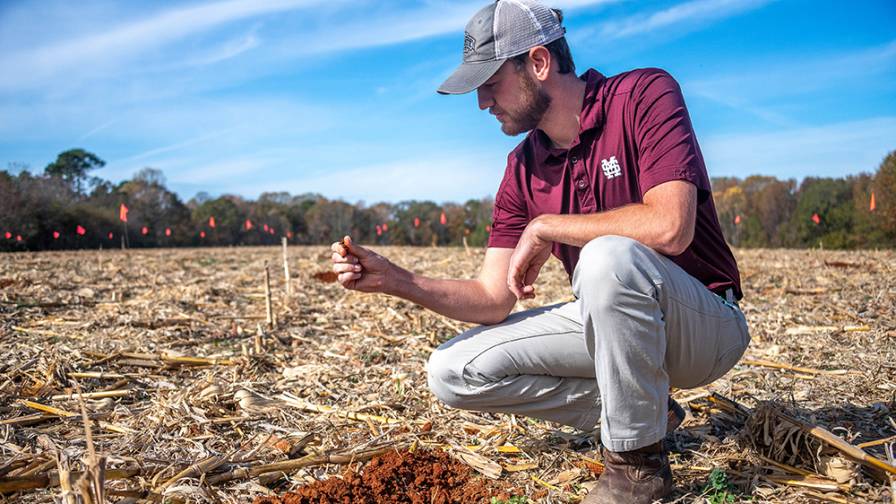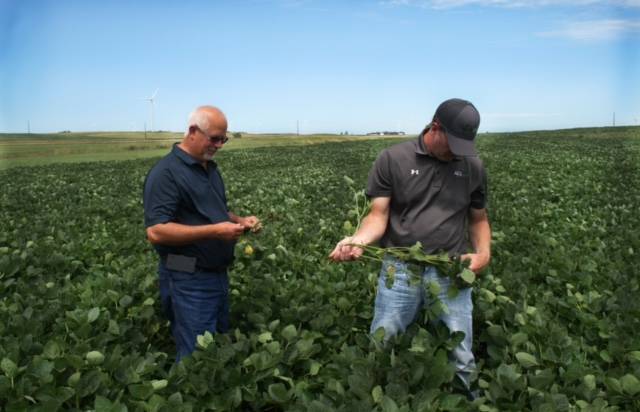Dicamba Update: When Drift Hits Tobacco
Dr. Matthew Vann has spent his entire life around tobacco, having grown up in northern Florida’s tobacco belt. For the past 10 years, he has lived in North Carolina where he has served as Tobacco Extension Specialist since 2015 with the Department of Crop and Soil Sciences at North Carolina State University. He chatted with CropLife on March 22 on how dicamba has affected the state’s most valuable crop and his expectations for 2019.

Matthew Vann talks with growers in a Georgia tobacco field.
It’s important to note that while a drift-damaged soybean field does not necessarily lead to yield reduction, tobacco that displays signs of dicamba drift can result in a complete loss of the crop – which remains the lifeblood of nearly 1,700 family farming operations in North Carolina.
CL: Where is tobacco ranked in terms of dicamba sensitivity versus soybeans?
That’s a loaded question, and I think there is a lot of debate on that in the scientific community regarding just how sensitive these crops are, because it really depends on growing conditions and the crop stage during the exposure and exposure rates, and all those kinds of things. I think usually, you could put soybeans and tobacco in the same category in terms of sensitivity. It is hypersensitive, is what I would prefer to say.
We’ve known this for decades because these are not new products. 2,4-D was one of the first synthetic herbicides that was commercially released; dicamba was released a short time later. We’ve always known that this class of herbicides can be extremely deleterious to tobacco growth.

Tobacco plant showing signs of dicamba drift damage. Photo credit: Matthew Vann
Depending on when the drift happens, you can have yield reduction and you may have quality issues after harvest – certainly that impacts grower profitability. But the bigger issue we have is, these products are not labeled for use in tobacco, so if exposure occurs it is technically an off-label application and is not in compliance with federal and state regulations. Simply put, in this scenario there has been an illegal exposure of that chemical to a non-labeled crop. That’s the bigger issue: that if you have a drift event, and tobacco makes its way into the supply chain, and there is a detection of illegal chemical, it starts to raise a lot of red flags with leaf buyers and product manufacturers.
CL: How would that scenario play out, if drift damage is detected?
Typically, what happens is once these visual symptoms start to show, farmers very quickly give Cooperative Extension a phone call. They’ll ask us to take a look and give our opinion. We do, and from there, they always reach out to the contract holders they have. Tobacco is a contracted crop, so they’ll call the leaf merchants or manufacturers they are selling leaf directly to and ask them to come out and take a look. Their contract holders will give an overview of what they see and tell them what they will buy and won’t buy based on those visual symptoms.
Pardon my pun here, but that’s really where the rubber meets the road. Somebody that you’re going to sell tobacco to comes out and says, ‘Yep, you have a 50-acre field, 10 of these acres look OK and we’ll buy those, but there are 40 acres we don’t want to have.’ That’s a significant loss right there for a farmer, because they are probably looking at $5,000 worth of revenue per acre.
CL: Is there insurance for this type of loss?
There are some small policies. Most of our farmers had been buying crop insurance, and certainly there is federal crop insurance for tobacco. Within some of those policies, there were line items and language specific to chemical drift, but what we very quickly found out in 2017 was that there were upper limits on what the payout would be for a chemical drift event.
In a lot of cases, we found it was only enough to cover 4 to 5 acres of tobacco, and if we’re looking at a 20-acre field, there is a big difference between the income of the insurance and what’s left over that can’t be used. There was a lot of learning on the fly in 2017 and in 2018, there were a lot more advertisements and education about rider policies that would increase the maximum payout. There are smaller insurance policies, but I don’t know if they ever get big enough to cover significant acreage if a big event ever took place.
CL: Do you know how much dicamba drift has cost farmers in North Carolina?
I don’t know if we really have an idea just yet. Going back to 2017, there were eight reported drift events specific to tobacco to our Pesticides Division. Last year, that number declined to two or three. The thing we don’t know within those reports is how many acres are affiliated with those events; we just know that they happened and they were officially reported. We haven’t quite put an estimate together just yet.
CL: What’s been your impression of how dicamba application has gone in your state and how big of a problem has it been for tobacco growers?
For me personally, because I only work with tobacco and it’s our most valuable crop – you’re looking at a farm gate value, depending on crop size, of $600 to $800 million just to farmers here in this state. We grow about 160,000 acres of tobacco in North Carolina, and 1.5 million acres of beans.
For me, I came into this situation with my guard up a little bit. This is a big deal. We grow tobacco across the state, and it’s one of our most sensitive crops – this is something we’re going to have an issue with.
I’ll be the first to say, that from a 50,000-foot view, when you look across the entire state, I don’t think we have had nearly the number issues I expected we would have. I think that is primarily due to the education and training that our Cooperative Extension Service provided going back to the onset of these new technologies being commercially available. Our Weed Science group has done an outstanding job. We’ve had three consecutive years of auxin-specific training for growers that were planning to use dicamba products – it was mandatory that they attend. There are typically between 30 to 40 trainings a year, and I think just because of that effort across entire state, we were able to provide a lot of user and grower education programs that have really helped us tremendously.
The problem has not been nearly as massive as I initially thought it would be. Our reported numbers in terms of drift events across all crops has been minute compared to what has been reported out of the Midwest. It’s just a much different scale.
On the flip side of that, if you talk to the handful of farmers that have reported these issues, it is a very big deal. As you start to talk to a grower that has 50 acres of tobacco with suspected dicamba drift, 50 times $5,000 per acre – that adds up pretty fast. In a lot of cases, that could be the difference between losing the farm and coming back next year, particularly in a weak ag economy like we have right now.
There are two sides of the coin, and I don’t think that’s tobacco-specific. If you talk to a soybean farmer in Illinois that has the same issue, they have the same concerns. I just think that with tobacco’s sensitivity, and the fact that pesticide residues in general are a massive talking point in our industry and training programs – you throw illegal pesticide residues in there, and the fact that there is potential for growers to lose their tobacco contract if illegal residues are found, that is a huge issue.
CL: Can you talk about your work with ag retailers, and what you’ve heard from them on this issue?
We work very closely with ag retailers around the state. A lot come to our Extension meetings to hear the latest tobacco updates and news.
I think the way they look at it, there are two sides. They have a product and some of these new herbicide technologies that farmers can use, and it’s certainly valuable in some places. But they also have tobacco farmers that they’re providing a service to. I think they’re trying to find the balance between these products and systems that we have here in the state that are fairly unique. I think that most of our retailers have been very conscientious of that.
I do know of some retailers that said, we will not be performing any custom application of these auxin technologies, just to protect the tobacco that’s grown in our marketing area. Some of them have taken a very firm stance, particularly in the heart of tobacco country east of Raleigh. For me, that’s a testament to the tobacco base we have here and certainly the value of that crop to the farm economy.
CL: Are you feeling good about 2019, based on how things have gone?
I think I do. I’ve got to give credit to the Weed Science group here at NC State. They’ve done an outstanding job. A lot of our tobacco farmers also grow other row crops and they’re going to these auxin training events. If we look at our numbers from 2017 and 2018 with drift events that were reported, those numbers went down. In total, we only had 13 or 14 drift events reported across all crops in 2017. That went to less than 10 in 2018. To see so few reports and even see them going down, I think we’re doing a good job. We’re certainly going to have to stay vigilant, and I implore our growers to follow these labels if they are using these herbicides around sensitive crops. If we can do all of that, I think we’ve got a shot at continuing to be what I think is a leader in the country with herbicide stewardship.






